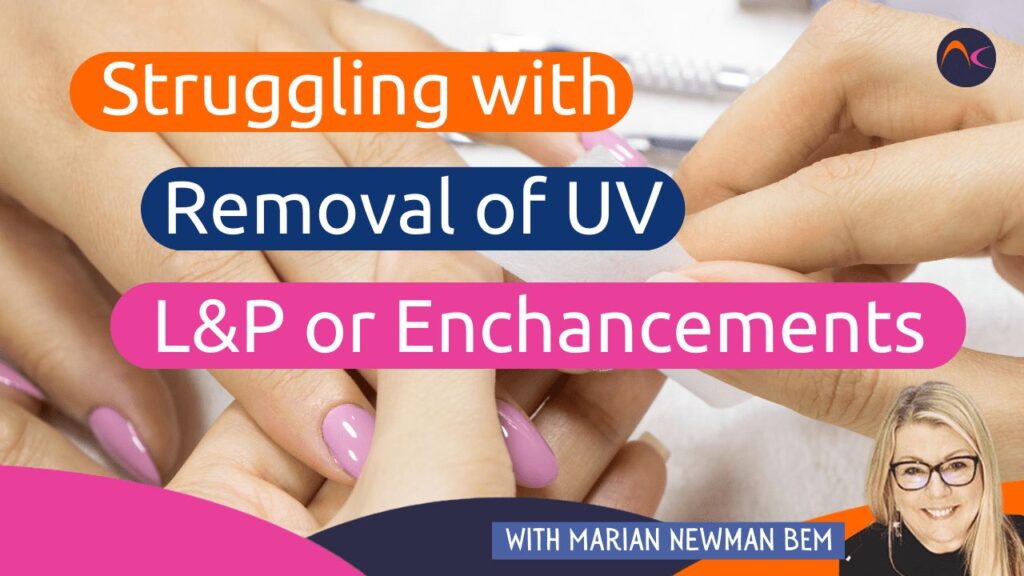Outra pessoa aplicou o sistema de unhas
Many seem to struggle with removals of UV and L&P overlays or enhancements. Especially if they have been applied by someone else.
There is really no reason to refuse to remove someones else’s work, not if you understand the science behind it. There is a good chance you could gain a new and loyal client.
A maioria dos sistemas de unhas pode ser removida por imersão
There are many different systems being used today but it is only a ‘hard gel’ that will not soak off and needs to be buffed off for removal. All other systems, including UV gel, L&P, sistemas de imersão (unless those with a hard UV gel), fibreglass, full cover tips etc. can be soaked off using acetone based products.
So what’s on your nails?
Como um guia aproximado:
UV gel based systems will soak off in 10-20 minutes. If there is no change in the coatings after this time then it could be a hard gel version that needs buffing to remove. Clients do not always know what is on their nails.
L&P will soak off in around 30 minutes. If it is one with an MMA monomer, then this will take several hours and will need buffing off (a very long job in itself)
Many UV gel polish systems use a hard gel top coat to help protect the colour from damage. The client may know this but unless you know for sure, it is often worth lightly buffing the surface to break it up and allow for the solvent to penetrate.
Métodos de remoção
- Imersão em acetona
Prepare um recipiente resistente a solventes com acetona suficiente para cobrir as unhas (não mais do que isso). Depois de polir a superfície, peça à cliente que coloque as unhas no solvente e deixe-as lá por pelo menos 10 minutos para começar,
Make sure the coating is starting to lift at this time. If not it may be a hard gel and will not soak off
Acelerar o processo
Tenha 2 tigelas, uma grande o suficiente para caber 10 dedos e outra maior.
Coloque acetona na tigela pequena, como acima, e água morna na tigela maior. Coloque a tigela pequena na tigela maior e peça ao cliente para colocar os dedos no solvente.
Cubra tudo com uma toalha para evitar que os vapores escapem.
Precaução
Certifique-se de que as tigelas estejam em uma mesa plana e não corram o risco de serem derrubadas.
Don’t use boiling water as this could make the solvent too hot and avoid burns if accidentally tipped over.
2. Remoção do envoltório
This is a similar method to the above but doesn’t use an open bowl. Instead, it uses tin foil to secure a cotton pad tightly on the nail that has been soaked in acetone.
É possível comprar papel-alumínio pré-cortado, mas o papel-alumínio de cozinha cortado em tamanhos apropriados também funciona.
Mergulhe o chumaço de algodão (metade ou metade da espessura funcionará) em acetona, coloque-o sobre a unha e envolva-o firmemente no papel-alumínio. Dobre a extremidade. Certifique-se de que esteja bem ajustado para garantir que o solvente não possa escapar e que a almofada fique presa contra a unha.
After around 10 mins, unwrap to see how the removal is progressing. It is likely to need some more solvent added to the pad and, as above if the coating isn’t moving, it may be a non-soak-off coating. Re-wrap until coatings are all removed.
Acelerar o processo
Colocar as mãos em luvas aquecidas acelerará enormemente o processo (mas certifique-se de que o forro esteja protegido da acetona com um forro ou luva sobre toda a mão).
Uma almofada aquecida também funciona, especialmente no inverno, quando as mãos dos clientes estão frias.
Pprecaução
Se estiver usando algum equipamento elétrico, certifique-se de que ele é seguro fazendo o teste PAT (consulte este blog)
3. Removedores aquecidos
Relativamente novos no setor são os aquecedores elétricos projetados para remoção. (Doug Schoon os analisou e os considerou seguros para uso se usados com responsabilidade)
Eles têm um recipiente para o solvente que fica em uma unidade aquecida.
Ele é coberto por uma tampa com orifícios para os dedos que possuem uma vedação para evitar que os vapores escapem.
Esse método significa que os dedos não precisam tocar o solvente e que os vapores sob a tampa serão absorvidos pelos revestimentos.
NB, vapours are actually the chemical. Much like steam from boiling water is still water.
Acelerar o processo
Tenha 2 unidades para que ambas as mãos possam ficar de molho ao mesmo tempo.
Precaução
Teste você mesmo a unidade primeiro. Algumas podem ficar bastante quentes, às vezes até demais, de modo que os dedos só precisam atravessar a tampa por um curto espaço de tempo.
Certifique-se de que a unidade esteja estável e não possa tombar ou ser puxada para fora da mesa.
A parte científica
Todo material tem uma certa quantidade de característica permeável (permite a penetração de moléculas), até mesmo o metal!!!
The structure of the molecules of every material will have gaps of varying sizes between them. Depending on the size and shape of the spaces and the shape and size of another material (e.g solvents, water, oil etc.)
Soak-off coatings have a molecular structure that allows for small molecules, such as suitable nail oils and acetone to penetrate and break the polymer bonds that formed during curing.
Os géis duros têm uma estrutura muito mais rígida que não permite a fácil penetração de um solvente (a acetona tem a menor molécula e, por isso, é o melhor removedor)
Hybrid gels are pure gels plus solvents. The solvents evaporate from the coating and as they do this they create a ‘tunnel’ where the solvent works it way up to the surface. This allows for very easy acetone penetration and is the fastest to remove.
Cyanoacrylates have a linear molecular structure allowing for easy penetration.
Dip systems with either a UV gel or a cyan acrylate can be harder to remove as the powder fills up a lot of the spaces in the polymer structure so making penetration difficult
The least amount of spaces does make for a stronger structure which is why many prefer hard gels for sculpting and enhancements. Hybrids and ‘soak offs’ are not as strong but this has a good compromise as being much faster to remove and less skin and nail exposure to drying solvents.
O L&P pode ser penetrado devido à estrutura polimerizada, mesmo que tenha ligações cruzadas avançadas. É por isso que a aplicação diária de óleo para unhas é importante, pois ele preenche os espaços e mantém a flexibilidade.
Cada tipo de produto tem uma razão para ser usado, dependendo das necessidades do cliente e da condição de suas unhas.
Precauções gerais
If your clients skin is dry or they don’t like the whiteness after contact with acetone, then oil can be applied for some protection. This can easily wash off so a balm or a product like Vaseline can be painted on to give more protection, but only on the skin and not the nail!
When the nails have been removed from the solvent, NEVER scrape off any remaining coating as the nail plate will be soft and very easily damaged. To remove any remaining product, just soak a cotton pad in acetone and rub the product off.
Acetone is a volatile solvent and evaporated easily, releasing the chemical into the air. Make sure you dispose of all remaining solvent, foils etc. safely and responsibly!
Absorva o líquido restante com uma toalha de papel e coloque-o em um recipiente coberto e forrado. OU coloque-o em uma área externa segura (onde crianças e animais não tenham acesso) e deixe-o evaporar.
Nunca despeje na pia ou no vaso sanitário, pois muitos canos são de plástico e os vapores podem se acumular nos esgotos!
Não é necessário que a remoção seja um procedimento difícil ou estressante. Seus horários só precisam ser levados em consideração.
Se você fornecer remoção gratuita caso tenha aplicado os revestimentos, inclua esse tempo em sua taxa. A remoção de outros trabalhos deve ser cobrada de acordo. Se você fizer reservas por telefone, há muitas coisas que podem ser verificadas nesse momento (não é tão fácil fazer reservas on-line)


